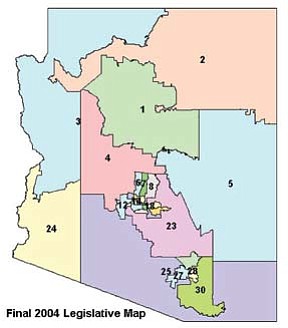Redistricting of Arizona's political districts will impact the Navajo and Hopi nations
NAVAJO AND HOPI NATIONS - If you have not figured out your state legislative and federal congressional voting districts yet, don't worry about them any longer. Results from the 2010 census have given cause for drawing-up new district lines to accommodate an increase and shift in Arizona's population. These new district lines will not bear any resemblance to the ones previously in place.
The redistricting process is considered an important matter by political leaders concerned citizens and community activists. It will impact elections in Arizona until the next census count in 2020. And, while redistricting could become an extremely political, highly contentious, and litigious event with legal challenges extending long after the redistricting maps are done, participants report that it is proceeding on a calm and congenial course.
Arizona now has a population of 6,392,017 up 24.6 percent from the previous census count of 5,472.750 in 2000. The increase and shift in its population requires the creation of new political districts for elections to the U. S. House of Representatives and the state legislature.
The state will also need to accommodate a new member for the U.S. Congress that has been justified by the state's population increase.
Traditionally, the Arizona state legislature was in control of drawing the political district boundaries after a decennial census count. The process tended to favor the political parties that were in power at the time. Essentially, incumbent office holders could select friendly voters for "their district" and map-out those who might be less supportive into another district. The name of the game was: Gerrymandering. It allowed the politicians create "safe districts" and select the voters rather than have the voters to select them.
Arizona voters grew to resent this process. In 2000 the citizens amended the state constitution and turned the responsibility for drawing political districts over to the Arizona Independent Redistricting Commission (AIRC).
The mission of the AIRC is to administer the fair and balanced redistricting of Congressional and Legislative districts for the State of Arizona. It is composed of five members - two Republicans, two Democrats, and one Independent.
Each of the state's 30 legislative districts will now represent approximately 213,000 people in the state legislature. The districts will have one representative in the Senate and two representatives in the House of Representatives.
Arizona's nine Congressional Districts will represent approximately 710,000 in the U.S. House of Representatives in Washington, D.C.
Now, even if you don't like math, the math is the easy part of the redistricting process. It could probably be accomplished with a few clicks of a mouse. In the modern world, however, nothing is ever as easy as it ought to be.
The AIRC will also need to comply with a complex set of legal requirements as they go about their business of creating new district voting maps.
Stewart Robinson, Public Information Officer for the AIRC, explained it this way in a recent interview with the Navajo-Hopi Observer. In addition to dividing the districts evenly according to the population, the Arizona constitution requires compliance with the United States Constitution and the federal Voting Rights Act of 1965. The AIRC must also take into consideration such matters as situation population, geographic compactness: geographic and political boundaries like those separating cities and counties: communities of interest: and the creation of competitive voting districts.
Robinson also said that the redistricting process could reduce some of the extremism associated with partisan politics and replace the "safe districts" enjoyed by both political parties with "competitive districts." There would be an incentive for politicians to compromise political positions and get on with governing and solving problems for the people of Arizona.
The IRC has already begun its first round of public meetings at locations around the state. Meetings are scheduled for Window Rock on Friday, Winslow on Saturday and in Flagstaff and Tuba City on Monday. Time and meeting places are available on the AIRC Website.
Once this round is over, in about two weeks, the Commission will issue a "grid map" depicting populations that will be used for the creation of the new political district maps.
"Our goal is to have the maps-making completed by the end of October," Robinson said. The maps will then be turned over the U.S. Department of Justice for final approval. Currently, the Navajo Nation's concerns about redistricting are being handled by the Human Rights Commission.
"We have had meetings with our Arizona state legislators, and representatives from various tribal government, cities and other local governments bordering the Navajo Nation in Arizona to address redistricting matters of mutual concern. We are in the process preparing tentative redistricting maps for consideration by the Naa' bik' i yati' (Navajo Nation Council) said Rachelle Todea, Public Information Officer.
"Upon approval by the Naa'bik'i yati our maps will be submitted to the Independent Redistricting Commission down in Phoenix," Todea added.
The Hopi Tribe recently issued a press release seeking input into the redistricting process from their tribal members.
"We are hopeful our membership will let their council members know if they prefer to remain in a congressional district that includes the western portion of suburban Phoenix, or if they would prefer that we recommend a congressional district that more closely resembles our state district boundaries," said Hopi Tribe Chairman LeRoy N. Shingoitewa.
"This is a real opportunity for our membership to have a say in our future legislative maps," Shingoitewa added.
The AIRC will be using state-of-the-art computer program called Mapit to assist them in the redistricting process. Members of the public will be able to offer suggestions regarding their own redistricting concerns.
AIRC meetings will be streamed live over their website and later made available on-line in the archives.
Additional information on redistricting can be obtained from the AIRC by visiting their website: www.azredistricting.org or by phone(602) 542-5221.
SUBMIT FEEDBACK
Click Below to:




